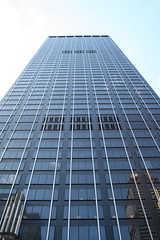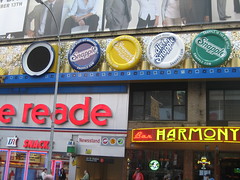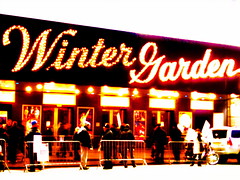South:Corner: Gershwin Apartments, a 40-story apartment development
built in 1998, named for the songwriting brothers. Includes
the Palm steakhouse and Thalia, Greek.
226: Amsterdam Court; includes Natsumi, Japanese restaurant/bar 216: Was Bare Elegance, seedy strip club
that was more of an ala carte brothel. Closed in 2010 for being too close to the Times Square Church. In 1914, Charles Chessar moved his legendary Beefsteak Charlie's restaurant here, which was a hangout for horseracing afficianados and later, in the 1950s and '60s, for jazz musicians. The restaurant later inspired a an East Coast chain, launched in 1976 and hanging on until the early 21st Century.
210 (corner): The Theater Center, an Off- Broadway house formerly known as the Snapple Theater Center. Perfect Crime moved here after playing since 1987 at the Duffy Theater, making it the longest-running play in New York history. (Still playing as of 2024.) Also at this address was Emmett O'Lunney's Harmony View, an Irish pub that didn't survive Covid; Emmett's father owned O'Lunney's on 45th Street. SUBWAY 1 to 42nd Street A stylish hidden bar, Nothing Really Matters, is accessed through the subway station here. |
W
|
North:Corner (830 8th Ave): Mario Ingrami and William S. Fryer designed this modernist building in 1985. 251: Frederico's, Italian Circle in the Square TheatreBuilt in 1972 as the third home of the Circle in the Square theater company (founded in 1951 on Sheridan Square). A rare example of theater-in-the-round on Broadway. Notable plays that premiered on Broadway here include Metamorphoses and The 25th Annual Putnam County Spelling Bee. Built on the site of the Capitol Theatre. (See next door.) Paramount Plaza
Corner (1633 Broadway): Originally known as the Uris Building, this 48-floor building went up in 1970 on the site of the Capitol Theatre, demolished in 1968. The 1919 cinema was designed by Thomas Lamb and was managed for a time by Samuel "Roxy" Rothapfel. It originally sat 5,300, making it the largest cinema in New York at the time and probably the world. It was the flagship of MGM's cinema chain; The Wizard of Oz and Gone With the Wind both opened here in 1939. The talent show Major Bowes' Original Amateur Hour, a huge phenomenon in its 1930s heyday, was broadcast from here on CBS Radio. The last movie to play here was 2001. Now houses the U.S. offices of Hachette Filipacchi, the world's largest magazine publisher; several of their American magazines are based here, such as Elle, Woman's Day and Premiere. Located in the sunken courtyard was Mars 2112, a touristy sci-fi-themed restaurant. SUBWAY 1 to 59th Street |

